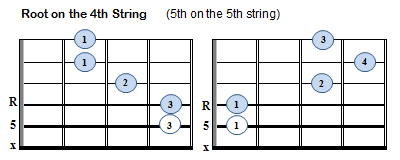
Left Handers

If the root note is an E, the chord will be E major...
The most common chord here is the middle one - also the standard 'E' form or E-shape chord.
If you play the 1st and 3rd example make sure you omit the 'x' marked strings.
You would tend to use the first example with finger-picking techniques, as it is hard to strum a chord without hitting either the 1st or 5th strings.
In the 3rd example, you may find it easier to barre the first 4 strings. It really makes no difference as long as you don't play the first string... unless you play the first string mirroring the 4th finger - a standard G-shape chord. You will need to alter your finger positions so that your 4th finger will now be on the first string. This alternative is quite hard to play as it requires a fair stretch... much easier if you omit the 1st string as the chart suggests.
Remember, to use movable chords you must know the notes on each fret. If you are using the chord charts above with the root note on the 6th string, you need to know the notes on each fret of the 6th string. The same applies to strings 4 and 5 with root notes on strings 4 and 5.

Left Handers

The most common chord here is the 1st chord - the standard A-shape chord.
If you decide not to use the optional notes, make sure you don't play the string.
The second example is a standard C-shape chord with the extra optional note which can also be played with the open C chord. It may be a little easier for some of you to play this chord with a full barre... it makes no difference because if you play the optional note, all strings are covered. If you do play a full barre, and don't play the optional note, don't play string 6... the same applies if you play the chord from the chart without the optional note.
The 3rd example is not commonly used, and a little awkward to play, but it can prove extremely useful in certain situations.

Left Handers

The most common chord here is the 1st chord - the standard 'F' shape with an added optional note. This is a great chord to know, and a very popular movable chord - you will find yourself using it all the time.
The second chord is a standard D-shape chord. When used in other positions, the chord is played with fingers 2, 3 & 4 with the first finger pressing down on strings 4 & 5. You may find it more comfortable to barre the first 5 strings and avoid playing the 6th string.

